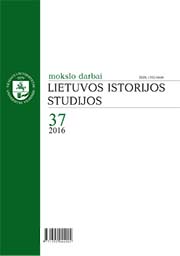PLUNGĖ: „ŽEMAIČIŲ DIEVŲ“ ŽEMĖS BENDRUOMENĖ XVIII AMŽIAUS PIRMOJE PUSĖJE*
PLUNGĖ: THE COMMUNITY OF SAMOGITIANS GODS’ LAND IN THE SECOND HALF OF THE 18TH CENTURY
Author(s): Eugenijus SaviščevasSubject(s): Cultural history, Local History / Microhistory, Demography and human biology, 18th Century, Migration Studies
Published by: Vilniaus Universiteto Leidykla
Keywords: local micro-history; parish register books; demography; migration; social mobility; Samogitians language;
Summary/Abstract: This article is a part of wider investigation. Its goal is to reconstruct the view of Plungė (in the 18th century – Plungėnai) parish community structure, the interaction of its social groups and routine life. The main source of research is three Plungė Catholic parish register books from 1697 to 1741. One of these books was written in Lithuanian (Samogitian). The study should be described as a local social microhistory. In the period from 1697 to 1741, Plungė town and parish experienced drastic changes. The growth of population number started from the second half of the 17th century was cut off in the middle of 1710. Plungė plague outbreak occurred in June–July of 1710. It reduced the population of the parish apparently by half and stopped the growth potential for about 25 years. In most cases all babies of the period were baptized just a few days after birth. The time of infant baptism and marriage showed that the community functioned following religious norms: sexual activity reduction during the Advent and Lent. The number of illegitimate children generally was not large. The striking increase in the number of illegitimate children in the 1st decade of the 18th century seems to have been associated with the dislocation of military units in the town. The registers of the period concerned show a high percentage of widows’ marriages: 39% of all marriages were held between persons either one or both widowed. On average, the wedding age was 105 20.5 years for girls, and 23.1 years for boys. Metrics records showed great geographical mobility of Plungė parish population, particularly striking the migration from village to town and back. Nearly a third of all the marriages were concluded between representatives of different parishes (mostly from Samogitian diocese). There were arrivals from distant countries: Rus’, Poland, Moskovia (Russia), Livonia and Germany. Often, they married locals and settled in Plungė parish. Social mobility occurred relatively freely migrating from peasant status to townsfolk status (due to marriage). We can suspect quite frequent lower nobility (from okolicas) marriage with peasants and town inhabitants, whereas high nobility did not enter such marriages.
Journal: Lietuvos istorijos studijos
- Issue Year: 2016
- Issue No: 37
- Page Range: 83-105
- Page Count: 23
- Language: Lithuanian

